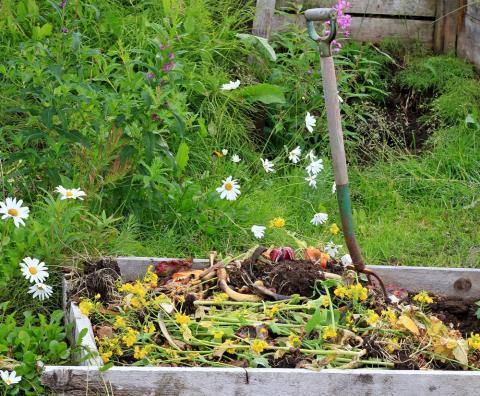
The conventional methods of putting the garden away involve pulling up your hard-grown plants and tilling your soil. While this method works for a few seasons, permaculture has a longer-term view of soil health. Tilling the soil destroys much of the delicate soil structures that allow for high levels of biodiversity. There are little pockets of water and air in the soil where nutrient-carrying mycorrhizal fungi can grow and beneficial insects can reside. Tilling also opens your soil to nutrient loss through erosion and the exposure of the nitrogen in the soil to the atmosphere. When old plants are pulled out of the soil, the soil structure, in addition to being damaged, loses the chance to develop new layers of complexity. Here you will find the step-by-step methods we use in permaculture to both preserve soil health and build soil diversity in our annual gardens.
1. Remove Your Annual Crops
Instead of pulling your crops up and tilling your soil loose, I suggest cutting your plants at the base, where the stem meets the soil. The roots of the plant will remain in the soil, slowly decomposing back into the soil while also leaving behind pockets where air and water can enter. You will need a good pair of garden shears or even loppers to achieve this task. Build a new compost pile with the plant material you remove from your garden.
2. Apply Compost
If you have a compost pile from which to draw, spread a layer a quarter-to-a-half-inch thick on top of the newly cut plants. Feel free to also purchase some organic composted manure or local compost of your choice. This is to give you a fluffy planting medium for the next step.
3. Select Cover Crop
There are many different types of cover crops to choose from, and it can be difficult to decide what to use. It is important to choose crops that will die off in the winter. Some organic farmers will choose crops that do great work for building nutrients in the soil but require tilling in order to stop them from growing. Once again, tilling breaks the delicate structure of the soil that builds the soil’s bio-diversity, and so it will be easier for you and better for your garden to make sure that the plants you choose do not need to be tilled in order to be effective.
There are also certain types of plants that have a strong symbiotic relationship with mycorrhizal fungi. These fungi are responsible for bringing important nutrients to the plants and add to the overall resilience of the garden. If you begin to think of your garden as needing the same soil composition of an ancient forest, you will begin to see how the permaculture techniques work.
4. Plant Cover Crop Seeds
I suggest using a combination of plants such as oats, field peas, and tillage radishes. All of these crops will die off once the winter chill seeps into the soil, so you won’t have to till them. Each one germinates easily, even at cool autumn temperatures, and they work together to build the nutrients of the soil. The oats give the field peas a structure on which to grow. Field peas fix nitrogen from the air into the soil and make it available to other plants. The oats in turn balance the amount of nitrogen in the soil with the amount of carbon in the soil. Tillage radishes burrow into the earth and are excellent for breaking up compacted soils or for simply adding more spaces for water and air to be held.
Make sure you purchase enough seeds to cover all your beds. You will need about half a pound of the mixed seeds for every 100 square feet of garden. Disperse your seeds generously across the surface of your garden beds, lightly fluff the soil up around them so that they are surrounded by the compost, and then gently press the seeds into the ground with the palm of your hand. The seeds do not need to be buried but they should be secure on the surface of the soil.
The seeds should begin to germinate within a week. Plant about a month before hard winter frosts are set to arrive in your region so that the plants will have time to grow at least five inches tall.
5. Plant Transplants in the Spring
The cover crops you planted will have turned brown and hopefully laid down by the snow over the winter. If you have not gotten snow in your region, you may need to give the leftover peas and oats a haircut before you plant in the spring. Lay the plant cuttings down on the surface of your garden. The plant remains will serve as mulch for your garden to suppress weeds and keep moisture in the soil. In order to plant new vegetables, use a bulb planter to cut out a hole in the soil in which you can place a potted plant or bury a new seed. Do not disrupt or take off the remains of the cover crops because they are holding the nutrients in the soil.
Permaculture techniques attempt to mimic the forest ecosystem, and so rely on the services of certain plants to do certain jobs. A forest never gets tilled by a tractor and our gardens do not need to be tilled either. Cover crops are an easier way to build soil health and diversity and will make your vegetable garden thrive year after year.








